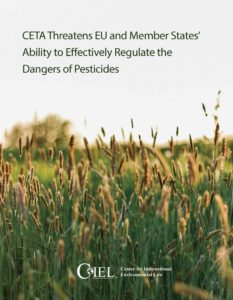
The EU-Canada Comprehensive Economic and Trade Agreement (CETA) is an agreement between the EU, its Member States, and Canada. The European Commission, Council of Ministers, and European Parliament have formally approved the agreement, and once Canada has ratified CETA according to its domestic procedures and notified the EU, most of the agreement will be provisionally applied. However, EU national parliaments must approve CETA before it can take full effect.
The main focus of CETA is to reduce differences in regulations, which are considered “trade irritants,” by encouraging the EU and Canada to harmonize their regulations. As the former Director-General of the World Trade Organization Pascal Lamy observed, “the real obstacles to trade and investment (between Canada and the EU) are differences in regulation.”
However, the EU and Canada regulate pesticides differently, and Canada has used trade mechanisms and instruments to lobby against EU pesticide regulations in the past. Regulatory convergence in pesticide regulation is therefore likely to lead to a lowering of EU standards.
CETA creates multiple forums for and imposes new obligations on EU and Canadian regulators to work towards regulatory convergence. CETA is also the first trade agreement formally approved by the EU that grants corporations the right to challenge EU policies and actions in private trade tribunals.
Taken together, these provisions provide Canada and companies doing business in Canada a variety of new tools to challenge and influence EU and EU Member States’ ability to regulate pesticides.
This report demonstrates that the national parliaments of EU Member States should vote against CETA ratification in order to preserve EU and its Member States’ ability to maintain strong pesticide management and to protect people and the environment from the harmful effects of pesticides.
This report begins by exploring trade rules and environmental health protections in EU food safety regulations in light of scientific uncertainty. Next, it examines the differences between EU and Canadian pesticide regulations, in particular regarding the approval of active substances in pesticides and the setting of Maximum Residue Limits (MRLs). The report then explores how regulatory cooperation under CETA could affect certain upcoming EU regulatory decisions. Finally, the report describes potential effects of CETA’s specific investors’ rights on EU regulatory processes that protect people and the environment from pesticides.
